Rock Garden Plants for Full Sun: A Complete Guide
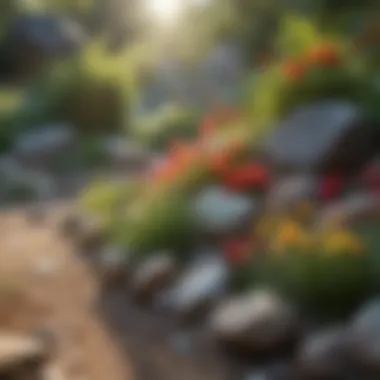

Overview of the Topic
Creating a rock garden that's bathed in sunlight offers a unique opportunity to blend aesthetics with functionality. Full sun rock gardens, often characterized by their vibrant colors and hardy plants, are not just visually appealing; they also provide essential ecological benefits. This area of gardening taps into both the beauty of nature and the principles of sustainable practices. Understanding how to choose the right plants is crucial not only for visual impact but for fostering a healthy ecosystem as well.
Rock gardens can be a whimsical spot in your yard or a strategic approach to land management in arid regions. These gardens thrive in rocky soil, which often drains quickly and allows for the cultivation of drought-resistant plants. In this guide, we will explore various species that flourish under full sun, the care they necessitate, and how they signify broader themes in gardening sustainability.
Current Status and Challenges
The current wave of urbanization has seen green spaces diminish significantly, which raises concerns about biodiversity and habitat loss. Many regions face escalating temperatures and prolonged droughts, making it imperative that gardeners choose plants that can survive and even thrive under these harsher conditions. Rock gardens often come to the rescue in such scenarios by utilizing indigenous and drought-resistant species, thereby contributing to environmental conservation.
However, challenges abound. The misuse of non-native plants or overzealous watering practices can counteract the ecological benefits rock gardens are meant to offer. Furthermore, garden enthusiasts might feel overwhelmed by the plethora of plant choices available, leading to mismanagement that can disrupt local ecosystems.
Sustainable Solutions
Opting for sustainable practices is vital in maintaining not only your rock garden but also the surrounding environment. Here are a few practical strategies:
- Choosing Native Plants: Utilizing species that are native to your region ensures that the plants are already well-adapted to the local climate and soil.
- Minimal Watering Needs: Select plants like Sedum, Thyme, and Alyssum, known for their low water consumption.
- Soil Health Management: Amending soil with organic materials like compost can improve structure and moisture retention, allowing plants to thrive even in dry spells.
One pertinent example involves community gardens in Phoenix, Arizona, which have successfully integrated rock gardens using native succulents into their urban landscape. This not only beautifies the area but also creates habitats conducive to pollinators and local wildlife.
Impact and Importance
Rock gardens are an essential part of the urban greening effort, offering a multitude of benefits not just for plant lovers but for local communities as a whole. By creating spaces that utilize full sun effectively, we engage in practices that contribute positively to biodiversity, soil health, and even air quality. Each garden acts as a mini-ecosystem that fosters various plant species, insects, and small animals.
The importance of such gardens cannot be overstated. In the face of climate change, they stand as a testament to what sustainable gardening can achieve. As stewards of the environment, engaging in rock gardening is not just about aesthetics; it reflects a commitment to preserving habitats and encouraging future generations to respect and appreciate nature.
"A garden in full sun doesn’t just grow plants; it nurtures communities and ecosystems, building a bridge between human inhabitants and the natural world.”
Intro to Rock Gardens
Rock gardens are more than just a visual delight; they represent a harmonious blend of nature and design that caters to both aesthetics and the environment. The essence of rock gardens lies in their ability to create structured landscapes that thrive in challenging conditions. By understanding the fundamentals, one can appreciate how these gardens transform spaces and benefit local ecology.
Definition and Concept of Rock Gardens
At its core, a rock garden is a cultivated space that showcases a symbiotic relationship between plants and stones. This concept encompasses a diverse range of rock types and plant species, which flourish in well-draining soil and bright sunlight. The stones placed within the garden are not mere decorations; they provide a natural habitat for a variety of flora and fauna. The right selection of rocks and plant arrangement allows for a micro-ecosystem to flourish, where resilient plants thrive in what often appears to be inhospitable conditions.
Historical Context
The origins of rock gardens can be traced back to ancient civilizations. For instance, the hanging gardens of Babylon, often likened to these landscapes, showcased an advanced understanding of gravity-driven irrigation and the beauty of foliage amidst stonework. Fast forward, in the 18th and 19th centuries, rock gardens gained prominence in Europe, especially in England, where horticulturists sought to recreate mountain habitats in their backyards. This movement led to the establishment of numerous botanical gardens that emphasized Alpine plants, showcasing their beauty and resilience. Understanding this historical backdrop enriches our appreciation for rock gardens today, reminding us how they have evolved yet retained their intrinsic value.
Benefits of Rock Gardens
Rock gardens offer a multitude of advantages for both gardeners and the environment. Some key benefits include:
- Water Efficiency: Once established, rock gardens require significantly less water than traditional gardens, making them ideal for drought-prone areas.
- Biodiversity: The varied flora encourages a range of wildlife, from pollinators like bees to beneficial insects such as ladybugs. This biodiversity is crucial for maintaining ecological balance.
- Soil Health: Many plants chosen for rock gardens, including certain succulents and perennials, contribute to soil formation and stabilization, even enhancing its nutrient profile over time.
- Low Maintenance: Once set up, these gardens often demand minimal upkeep, appealing to busy individuals who still wish to enjoy nature’s beauty.
"A rock garden isn’t merely a collection of stones; it’s an ecosystem that blends beauty, resilience, and the art of gardening."
In summary, the introduction to rock gardens sets the foundation for understanding their role in sustainable gardening practices. This guide will dive deeper into the specifics of cultivating plants that thrive under full sun conditions, paving the way for vibrant and ecologically beneficial outdoor space.
Understanding Full Sun Conditions
In the realm of horticulture, understanding the nuances of full sun conditions is paramount, particularly when planning a rock garden. Full sun implies that a spot receives at least six hours of direct sunlight per day. This consistent exposure is imperative for various plant species, ensuring they flourish and demonstrate their full potential. Crafting a successful rock garden starts with recognizing how sunlight influences plant choice, growth patterns, and overall health.
Defining Full Sun
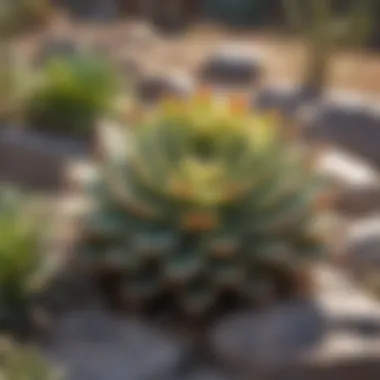
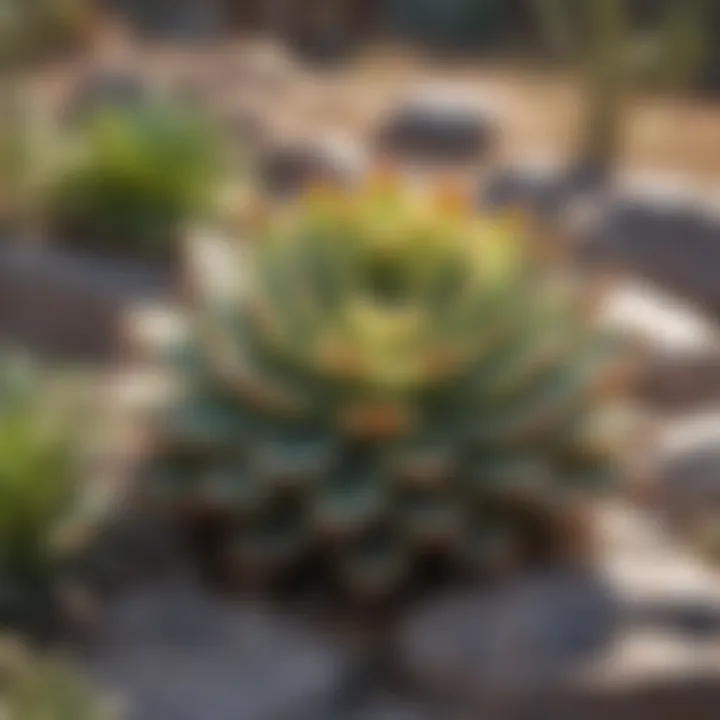
Full sun is a term often tossed around in gardening circles, but what does it really mean? Besides the six-hour benchmark, it can also include areas that receive reflected sunlight, such as those positioned near a wall or a patio with hardscape features. The sun’s path changes with the seasons, so taking note of morning versus afternoon light is essential. Some plants thrive under warmer afternoon rays, while others may prefer the gentler morning sunshine.
"The right amount of sunlight can make or break a plant's success; it's like giving them a warm hug every day."
Soil and Water Considerations
When delving into the specifics of planting in full sun, soil quality and watering practices play crucial roles. Well-draining soil is non-negotiable. Plants in rock gardens often hail from arid environments where drainage is swift. Soil mixtures should ideally comprise sand, gravel, and organic compost to encourage aeration while supporting nutritional needs.
Regarding watering, a common mistake is to overwater. Once established, many full sun rock garden plants are drought-tolerant. However, during their initial growth phase, consistent moisture is critical. Effective practices include:
- Watering early in the morning to avoid evaporation.
- Using mulch to retain moisture while reducing weed growth.
- Monitoring soil moisture through a finger test—if the top inch is dry, it’s time to water.
Climate Factors Affecting Growth
Climate embodies more than just numbers; it's the atmosphere that creates a thriving garden ecosystem. Temperature swings, humidity levels, and seasonal changes significantly affect plant behavior. For example, while some plants may handle high temperatures well, others might succumb to heat stress, wilting or losing leaves.
Climate zones vary significantly. Understanding your local climate can guide selection. Plants like lavender, which favor drier conditions, may not fare well in humid environments. Additionally, as the seasons shift, perennials that thrive in one season may enter dormancy during others, raising the need for careful planning on which species to pair together for visual continuity throughout the year.
Selecting Plants for Full Sun Rock Gardens
When creating a sustainable rock garden that basks in the sun, picking the right plants is fundamental. Choosing suitable species not only ensures that your plants thrive but also enhances the overall aesthetics and biodiversity of your garden. Full sun conditions can be unforgiving; thus, understanding which plants suit these environmental demands becomes paramount. This section covers a range of plants, discussing their characteristics, benefits, and how they can seamlessly integrate into a rock garden design.
Creeping Thyme Varieties
Creeping thyme is a treasure trove for sun-loving rock garden fans. These hardy plants are not just beautiful, they serve a variety of purposes. They’re excellent ground covers, effectively choking out weeds while also adding texture and color. Varieties like Thymus serpyllum and Thymus praecox are particularly popular.
- Flowering: In summer, expect delicate purple or pink flowers that attract bees and butterflies. This makes them wildlife-friendly.
- Drought Resistance: Once established, creeping thyme requires minimal watering, making it a perfect choice for conservation-minded gardeners.
- Soil Preference: This hardy plant does well in rocky, well-drained soil, an essential consideration for your rock garden.
Sedums and Succulents
Sedums and succulents can bring a unique flair to your rock garden. Their fleshy leaves and diverse shapes create a dynamic visual that stands out in sunlight.
Sedum morganianum, commonly known as burro's tail, is a showstopper with its trailing habit. Other varieties, like Sedum rubrotinctum, reveal striking colors under the sun.
- Low Maintenance: These plants thrive on neglect. An added bonus for busy gardeners.
- Water Conservation: Sedums and other succulents store moisture in their leaves, making them perfect for dry conditions.
- Variety: Available in numerous shapes, sizes, and colors, they can be mixed and matched to create eye-catching displays.
Perennials Ideal for Sun Exposure
Perennials add depth and dimension to rock gardens. Plants like Echinacea purpurea (coneflower) and Achillea millefolium (yarrow) not only endure but flourish in full sun.
- Long Lifespan: Compared to annuals, these plants return each year, providing continuous beauty and structure to your garden.
- Color and Texture: They offer a plethora of colors, from the bold oranges to soft yellows, adding vibrancy to the landscape.
- Ecological Benefits: Many perennials are crucial for attracting pollinators such as bees and butterflies, enhancing biodiversity around your garden.
Annuals to Consider
Don’t overlook annuals when planning your sun-drenched rock garden. Plants like Tagetes patula (marigolds) and Zinnia elegans provide a burst of color that can be changed year after year.
- Seasonal Variation: Utilizing annuals allows you to refresh your garden's look annually, experimenting with different color schemes.
- Rapid Growth: These plants tend to establish quickly, giving instant results to your gardening efforts.
- Pest Deterrence: Many annuals, like marigolds, help repel certain pests, providing an organic form of pest control.
Remember: The plants you choose should harmonize with the environment, thrive under sun exposure, and contribute positively to the landscape's overall health.
Ensuring a well-curated collection of full-sun plants enriches your rock garden, providing beauty and resilience to withstand the harsher climate. Each selection influences not only the aesthetic appeal of your space but also the ecological footprint it leaves in the world.
Design Principles for Rock Gardens
Designing a rock garden entails more than the mere arrangement of stones and plants. It’s about creating a harmonious space that echoes the natural landscapes found in mountains, hillsides, and rocky outcrops. In a full sun rock garden, specific design principles come into play, making this undertaking not just an aesthetic choice but a strategic one to ensure both the beauty and sustainability of the garden.
Layering Plants for Aesthetics
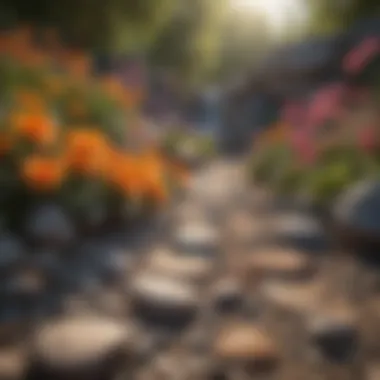

Layering plays a major role in crafting a visually appealing rock garden. This approach involves positioning plants at varying heights, combining both tall and short species to create depth and interest. By doing so, you can easily highlight the unique textures and colors of different plant types.
Imagine the soft, creeping tendrils of Creeping Thyme wending their way around the sturdy Sedum. The interplay between these plants can create a tapestry of color and shape. When planning this layering, consider the mature height and spread of each plant; planting them too close can lead to overcrowding and reduced airflow.
Benefits of Layering:
- Visual interest: Layered plantings draw the eye and keep the landscape dynamic.
- Microclimates: Taller plants can provide shelter for smaller varieties, creating a suitable environment for more delicate species.
- Increased biodiversity: A diverse plant palette attracts various beneficial insects and pollinators, enhancing the ecological impact of your garden.
Incorporating Stones and Structures
Stones are foundational to rock gardens, both structurally and visually. The way you incorporate them can transform not only the look but also the functionality of the space.
Natural stones, arranged at various angles, provide a sense of permanence and can serve multiple purposes, like defining planting areas or acting as borders between different sections of the garden. Using larger boulders at intervals can offer focal points, while smaller rocks can create paths or mazes for wandering through the greenery.
It's essential to choose stone types that blend well together and with your surrounding landscape. Consider local materials not just for aesthetic appeal but also for environmental reasons; they’ll often require less maintenance and will weather more harmoniously over time.
Practical Tips for Stone Incorporation:
- Variety: Mix different shapes and sizes; avoid monotony.
- Natural placement: Aim for an organic feel as though the stones have always belonged there.
- Usability: Ensure paths are accessible and stones are not a tripping hazard.
Color Schemes and Harmonization
Colors can either complement or clash, and in a rock garden, getting this right is crucial for creating a peaceful retreat. When selecting plants, consider their foliage as well as their flowers throughout the seasons. Bold colors can create excitement, while more muted tones may evoke calm.
Using a color wheel can help you visualize how different hues interact. For instance, pairing warm colors like reds and yellows with cooler shades like blues and purples can create vibrant contrasts.
Also, consider the bloom times of your plants. A garden that sports colors changing with the seasons can be far more engaging.
Points to Remember:
- Contrast: Balance bold colors with subtler hues to avoid overwhelming the eye.
- Seasonality: Plan for color changes as the seasons shift; this keeps the garden lively year-round.
- Texture accord: Subtle differences in texture can enhance the colors and create more depth visually, making plant choices even more essential as relating to color harmony.
"A well-designed rock garden is like a living painting, where each season offers a new stroke of beauty and detail."
With careful attention to these design principles, your sun-drenched rock garden can flourish, providing not just a view but a serene retreat into nature.
Maintenance of Full Sun Rock Gardens
Maintaining a full sun rock garden goes beyond just planting the right species. It is a continuous process that requires attention and care to ensure that the garden remains vibrant and healthy throughout the growing season. Proper maintenance not only enhances the aesthetic appeal but also contributes to the longevity of the plants and the wellbeing of the entire ecosystem in which these gardens are situated. By being proactive in routine tasks, gardeners can create a sustainable environment that thrives despite challenges such as drought, pests, and soil erosion.
Watering Practices
Water is life, as the saying goes, and in a full sun rock garden, efficient watering practices are crucial. Many plants suited for these environments often have deep roots and drought tolerance, but they still require proper hydration to flourish. Given the exposure to direct sunlight, evaporation rates can be high in these gardens.
- Water deeply to encourage the roots to grow down into the soil where moisture is available. A slow and steady approach is better than quick, shallow watering.
- Early morning is typically the best time to water. This allows plants to absorb moisture before the heat of the day sets in.
- Mulching can be a simple yet effective technique. A layer of organic mulch not only retains moisture but also regulates soil temperature, benefitting the plants.
Proper watering habits not only support plant health but also enrich the soil ecosystem, helping beneficial microorganisms thrive.
Fertilization Techniques
Fertilization is another key element in the maintenance of rock gardens. While many rock garden plants are adapted to grow in less fertile soil, they can still benefit from the right nutrients. Here’s how to ensure they get what they need:
- Use slow-release fertilizers once in spring to provide a steady supply of nutrients.
- Organic compost can enhance soil structure and provide nutrients over time. It improves drainage and aeration, which is essential in rock gardens.
- Foliar feeding can help if certain plants show signs of nutrient deficiency. This involves applying fertilizer directly onto leaves, allowing for quicker absorption.
Weed and Pest Management
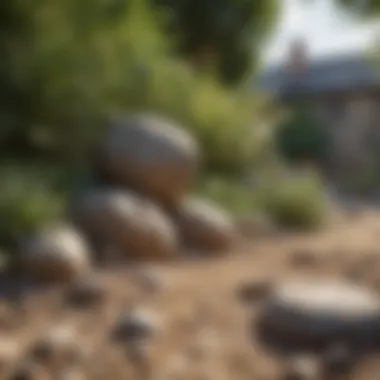

Weeds can be a persistent nuisance in any garden, and full sun environments can be particularly inviting for them. Prevention is often the best strategy:
- Weed regularly, especially after rain or watering when the soil is soft. Using a hand pull or hoe can minimize further disruption to the roots of surrounding plants.
- Consider using a weed barrier under the mulch. This can significantly reduce weed growth while allowing moisture to pass through.
- Addressing pests involves regular observation. Many critters can be managed through natural means, such as encouraging beneficial insects like ladybugs and lacewings.
Seasonal Care Routines
A rock garden truly speaks to the changing seasons, and each period requires different care routines. Here's a breakdown:
- Spring: This is the time for planting and fertilizing. As temperatures warm, ensure that all plants are well-watered to encourage growth after dormancy.
- Summer: Monitor moisture levels closely. Deadheading spent flowers will promote further blooming in many perennials and maintain a tidy appearance.
- Fall: A thorough clean-up of debris and dead plants is essential. Consider adding compost to improve soil health over the winter.
- Winter: Protecting delicate plants from severe weather is paramount. Using burlap or other frost covers can shield them.
By staying on top of these maintenance tasks, a full sun rock garden can remain a bustling sanctuary. Support it with consistent care, and it’ll reward you with vivid colors and thriving habitats for years to come.
Environmental Impact of Rock Gardens
The layout and choice of plants in rock gardens can have significant ripple effects on the surrounding environment. By focusing on beneficial practices, we can create green spaces that do more than just look good. They contribute towards the delicate balance in nature. Rock gardens, particularly those situated in full sun, can be designed to amplify their environmental benefits, ranging from promoting biodiversity to conserving precious water resources.
Promoting Biodiversity
One of the most compelling reasons to adopt rock gardens is their capacity to support a wide range of plant species and wildlife. These gardens become mini ecosystems, acting as refuge for various organisms. This diversity isn't merely a paradise for plants - it attracts all kinds of creatures, including birds, insects, and small mammals. By including native plant species in your rock garden, you can create an inviting atmosphere that encourages local wildlife to thrive. Native plants, after all, are well-adapted to the local climate, soil conditions, and pests.
- Supports local species: The varied vegetation provides food and habitat for birds and pollinators.
- Enhances genetic diversity: More species mean a better chance for plant and animal populations to adapt to environmental changes.
- Improves plant health: A diverse environment can help reduce pest populations naturally, minimizing the need for chemical interventions.
In essence, rock gardens can flourish as living laboratories, teeming with life and opportunity for ecological learning.
Conserving Water Resources
Water scarcity is a pressing concern across the globe. Rock gardens offer a practical and aesthetically pleasing solution for individuals looking to create sustainable landscapes. These gardens often use drought-tolerant plants that require less water than traditional flowering beds. Couple this with the natural contour of rocks, which retains moisture effectively, and you've got a winning formula.
- Drought-resistant plants: Species like succulents or native grasses can thrive in sunny areas while using minimal water.
- Rainwater harvesting: Designing rock gardens to capture rainwater can further reduce dependency on irrigation systems.
- Soil health: Promoting healthier soil through the use of mulch and organic matter can aid in moisture retention as well.
Embracing such techniques not only eases the burden on water supplies but also provides a model of sustainability for others to follow.
Supporting Pollinator Habitats
Pollinators are the unsung heroes of our ecosystems. Rock gardens can serve as vital sanctuaries for them, especially as more natural habitats are lost to urban development. By selecting the right plants, a rock garden can transform into a buffet for bees, butterflies, and hummingbirds, helping to address the alarming decline in pollinator populations.
- Flower varieties: Choose plants with varied bloom times to provide a continuous food source throughout the seasons.
- Minimize pesticide use: Reducing or eliminating synthetic chemicals creates a safer environment for pollinators.
- Considerations for habitat: Including small areas of wildflowers or water features can enhance the attractiveness of your rock garden to pollinators.
Creating these habitats fosters a symbiotic relationship where both plants and pollinators benefit, thus enhancing the local ecosystem's resilience.
"Every plant and animal has a role, and when we create spaces for them, we pave the way for livelier, healthier environments."
End
In the realm of gardening, embracing the wisdom of rock gardens, particularly those basking in full sun, presents not only a vibrant yet hardy aesthetic but also fortifies ecosystem resilience. As we draw this exploration to a close, it’s crucial to reflect on the many facets highlighted in our discussion. The art of selecting plants that thrive under the relentless gaze of the sun is a delicate balance of choosing varieties that not only endure but also flourish.
This article cultivated a deeper understanding of the benefits these sun-soaked spaces offer.
Recap of Key Points
- Fostering Biodiversity: Full sun rock gardens serve as sanctuaries for various species, welcoming a plethora of flora and fauna, which contributes to a rich, diverse habitat.
- Water Conservation: By selecting drought-tolerant plants such as succulents and sedums, gardeners can create a lush landscape while minimizing water usage, an increasingly important factor amidst climate change.
- Supporting Pollinators: The strategic integration of flowering plants promotes vital ecosystems, particularly for bees and butterflies, who are essential for healthy plant growth.
Understanding these aspects is imperative, providing insight into how such gardens can effectively fit within eco-friendly practices.
Encouragement for Eco-friendly Gardening
Gardening, at its core, should transcend beyond mere aesthetics. The invitation here is to think bigger – to embrace a mindset of sustainability. Reflect upon these principles when tending to your own piece of earth:
- Choose Native Varieties: Native plants often require less water and are adapted to the local climate, making them a sensible choice for a low-maintenance garden.
- Practice Responsible Watering: The application of drip irrigation or rain barrels can significantly reduce wastage while ensuring the plants receive adequate hydration.
- Avoid Harmful Chemicals: Opt for organic fertilizers and natural pest control methods. This not only preserves the health of your garden but also protects surrounding wildlife.
"Cultivating a rock garden may seem like a simple endeavor, but it holds the power to create significant ecological ripples."
By integrating these practices into your gardening philosophy, you contribute to an environment that is not only beautiful but also sustainable. Let each plant you choose echo the call for conservation, and may your rock garden stand as a testament to the harmony between humans and nature.



